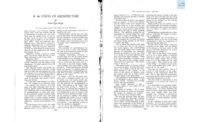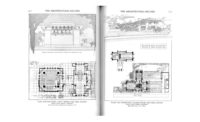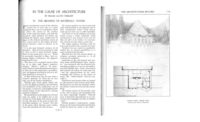From Architectural Record, December, 1928. Read a PDF of the original article here.
Enough, by now, has been said of materials to show direction and suggest how far the study of their natures may go. We have glanced at certain major aspects of the more obvious of building-materials only, because these studies are not intended to do more than fire the imagination of the young architect and suggest to him a few uses and effects that have proved helpful in my own work. The subject has neither bottom, sides nor top, if one would try to exhaust “the nature of materials”! How little consideration the modern architect has yet really given them. Opportunity has languished in consequence and is waiting, still.
Perhaps these articles have been guilty of “poetic” interpretation now and then, turning these “materials” over and over in the hand. The imagination has caught the light on them, in them as well, and tried to fix a ray or two of their significance in the sympathetic mind.
POETRY, POETIC, ROMANTIC, IDEAL.
These words now indicate disease or crime because a past century failed with them and gave us the language of form – instead of the significant form itself.
So if we are not to fall into the category of “language” ourselves, I owe an explanation of the meaning of these words, for I shall continue to use them.
It has been common practice among artists to apply the terms qualifying one art to another art – say, those of Music to Architecture or vice-versa. This may be done because certain qualities in each are common to all. It may be helpful to make comparisons between them to bring out particular significance, as our English vocabulary is poor at best in all the words we have with which to express shadings of qualities or of our feeling in dealing with qualities.
We can hack away at the thing with our body-terms and get the subject anywhere or nowhere except misunderstood.
Nor do we speak a common tongue in the use we have come to make of these main words. We may pack into each of them more or less, and differently, than another would dream of doing, or could do. So it is well to clean them up – for now we are going to write about the uses and purposes of “materials” increasing this thing we name Architecture.
“Poetry of Form,” for instance, is a phrase that will now make almost any sensible man sick.
The word “poetry” is a dangerous word to use, and for good reason. Carl Sandburg once said to me, - “Why do you use the words ‘poetry,’ ‘beauty,’ ‘truth’ or ‘ideal’ any more? Why don’t you just get down to tacks and talk about boards and nails and barn doors?”
Good advice. And I think that is what I should do. But I won’t, unless I can get an equivalent by doing so. That equivalent is exactly what I cannot get. Those words – romance, poetry, beauty, truth, ideal – are not precious words – nor should they be specious words. They are elemental human symbols and we must be brought back again to respect for them by using them significantly if we use them at all, or go to jail.
Well, then – our lot being cast with a hod of mortar, some bricks or stone or concrete and the Machine, we shall talk of the thing we are going to do with these things in the terms that are sensible enough when we speak of the horse-hair, cat-gut, fine wood, brass and keys, the “things” that make up the modern orchestra. By the way, that orchestra is New. Our possibilities in building with the Machine are New in just the same sense.
Although Architecture is a greater art than Music (if one art can be greater than another) this architect has always secretly envied Bach, Beethoven and the great Masters of Music. They lifted their batons after great and painful concentration on creation and soared into the execution of their designs with a hundred willing minds – the orchestra – and that means a thousand fingers quick to perform every detail of the precise effect the Master wanted.
What a resource!
And what a facility they were afforded by forms – they made them – moving according to mood from fugue to sonata, from sonata to concerto – and from them all to the melodic grandeur and completeness of the symphony.
I suppose that is well that no architect has anything like it nor can ever get it.
But as a small boy, long after I had been put to bed, I used to lie and listen to my father playing Beethoven – for whose music he had conceived a passion – playing far into the night. To my young mind it all spoke a language that stirred me strangely and I’ve since learned it was the language, beyond all words, of the human heart.
To me, architecture is just as much an affair of the human heart.
And it is to architecture in this sense that we are addressing ourselves. We are pleading here in that cause.
What, then, is Poetry of Form?
The term has become a red rag or a reproachful tag to architects at home and abroad. And, too, it is something that clients are, to some degree, infected by this contact with architects. And some of the best among them fall ill with Neo-Spanish that was itself Neo-Italian or some kind of Renaissance of the Renaissance, or linger along Quasi-Italian, or eventually die outright of Tudor or Colonial.
It is a new form of the plague – “this poison of good taste,” as Lewis Mumford has precisely called it. This “poison” has cursed America for generations to come. And this happened to the good people who spoke the language of “Poetry of Form” and hopefully sought the “Romantic” when they became clients.
“Poetry of Form,” in this romantic, popular sense, has not only cost wasted billions in money but has done spiritual harm beyond reckoning to the America of the future. But the fact remains that America wanted it and sought it. The failure is less significant than the fact.
So instead of speaking of “Poetry of Form” in buildings, perhaps, after all, we would do better to say simply the natural building, naturally built, native to the region.
Such a building would be sure to be all that Poetry of Form should imply, and would mean a building as beautiful on its site as the region itself.
And that word ROMANCE, Romantic or Romanza, got itself born in literature a century ago. Later Novalis and his kind chose the blue flower as its symbol. Their Romance was rather an escape from life than any realization of the idealization of it. As the word is popularly or commonly used today, it is still something fanciful, unlike life. At least it is something exotic. “Romance” is used as a word to indicate escape from the pressure of the facts of life into a realm of the beyond – a beyond each one fashions for himself or for others as he will – or may – dream.
But in music the Romanza is only a free form or freedom to make one’s own form. A musician’s sense of proportion is all that governs him in it. The mysterious remains just enough a haunting quality in a whole so organic as to lose all tangible evidence of how it was made – and the organic whole lives in the harmonies of feeling expressed in sound. Translate “sounds and the ear” to “forms and the eye” and a Romanza, even, seems reasonable enough, too, in architecture.








Post a comment to this article
Report Abusive Comment